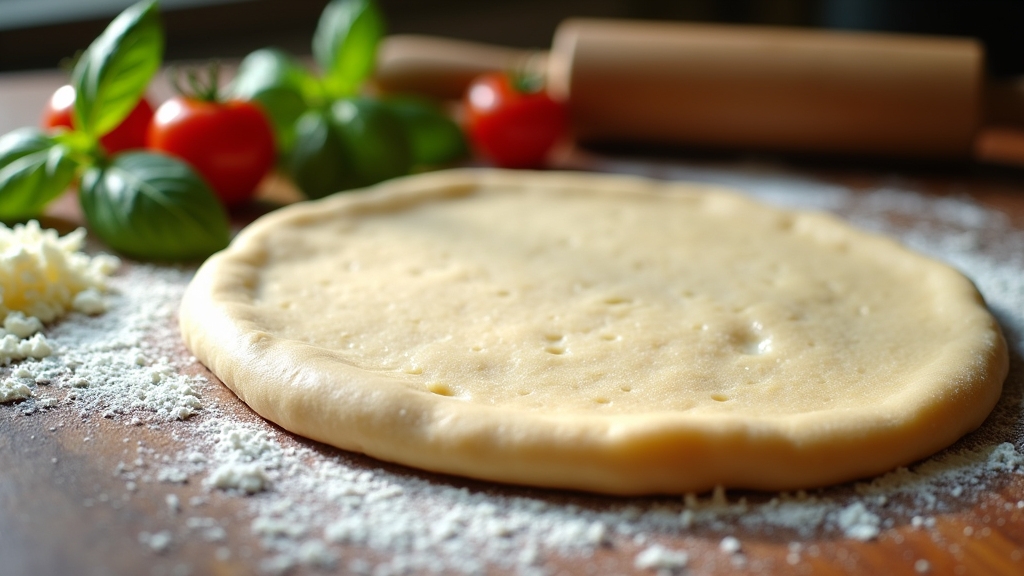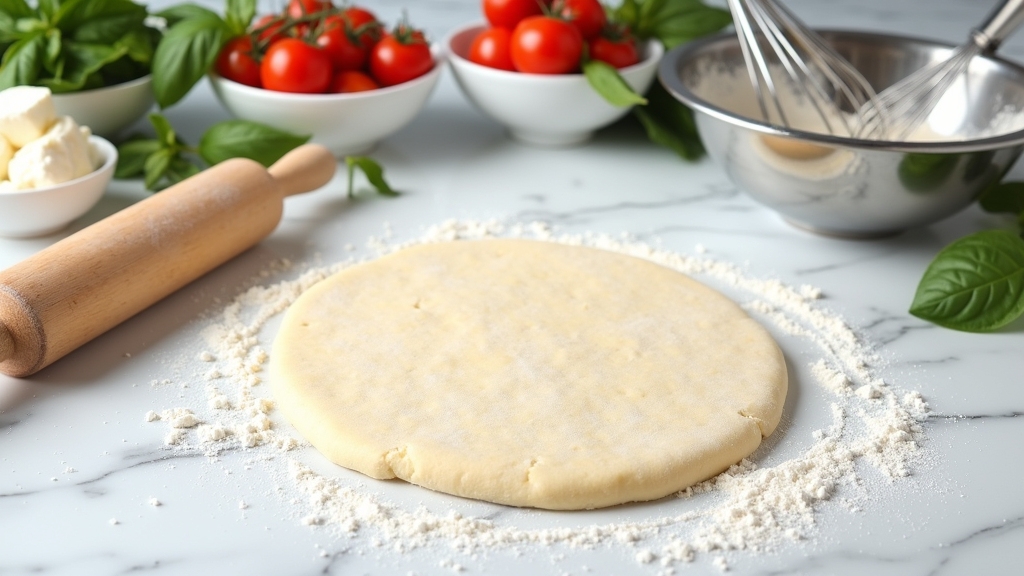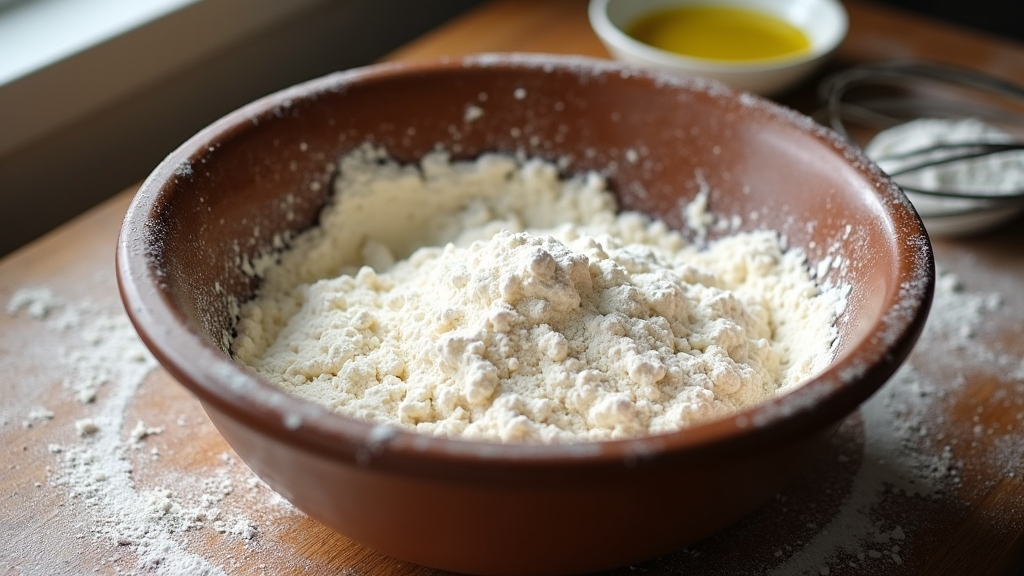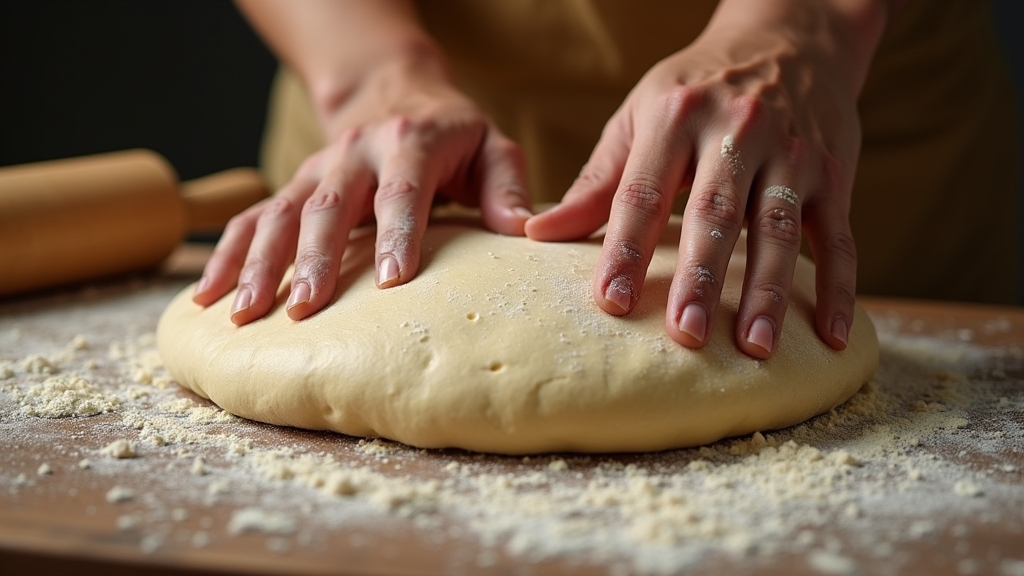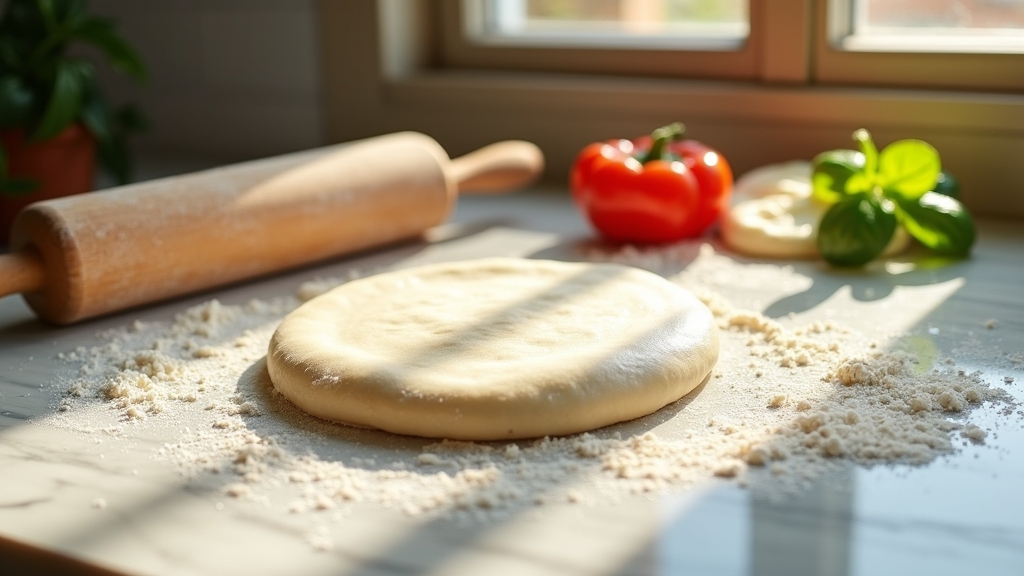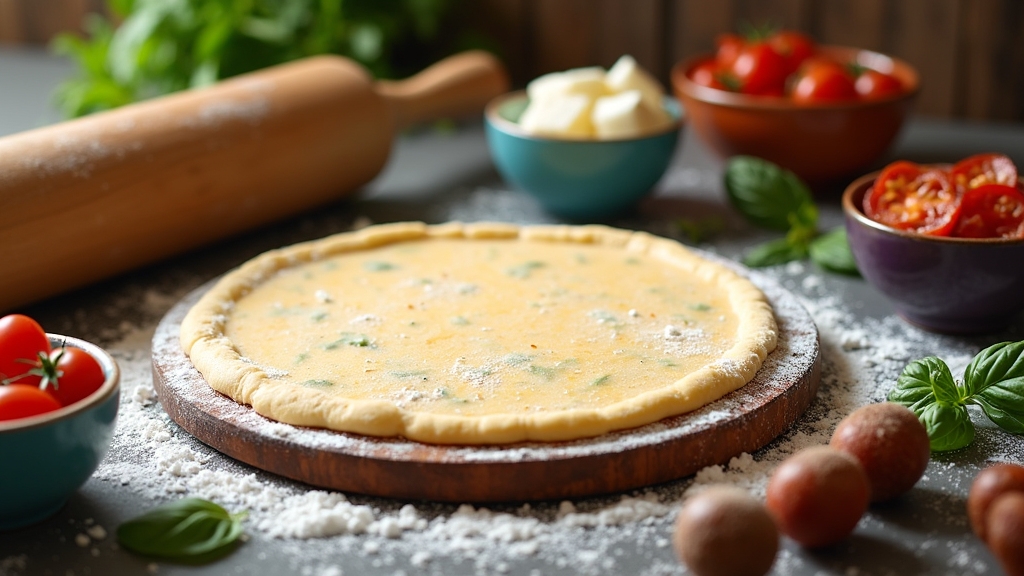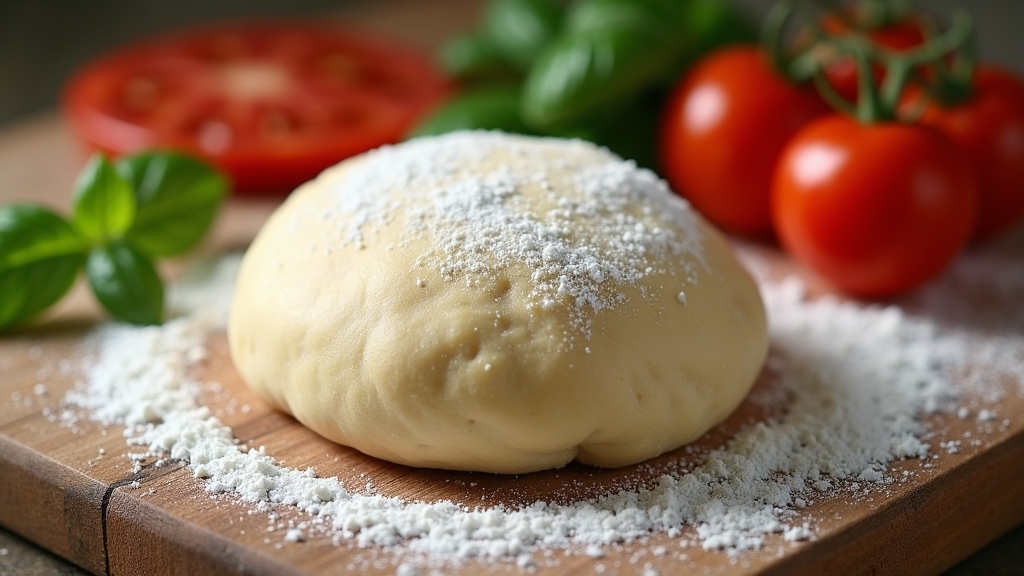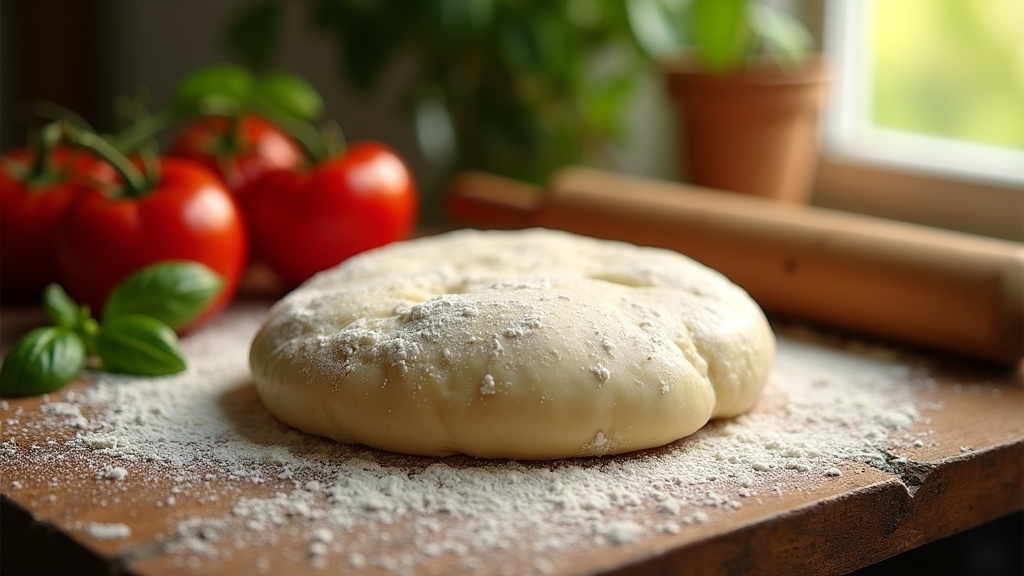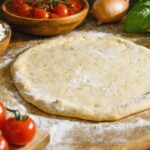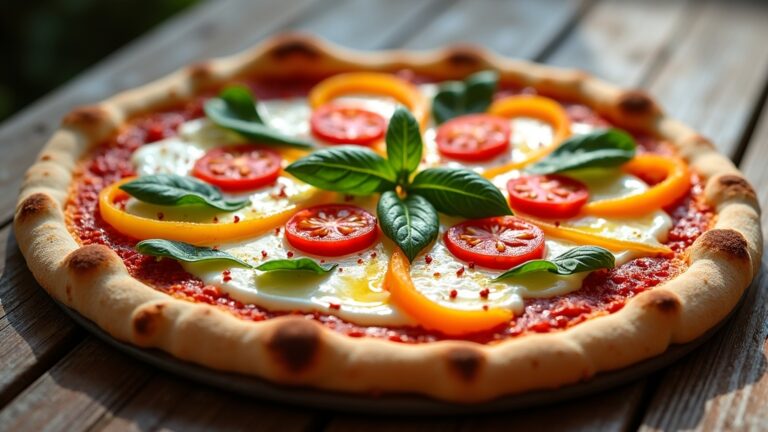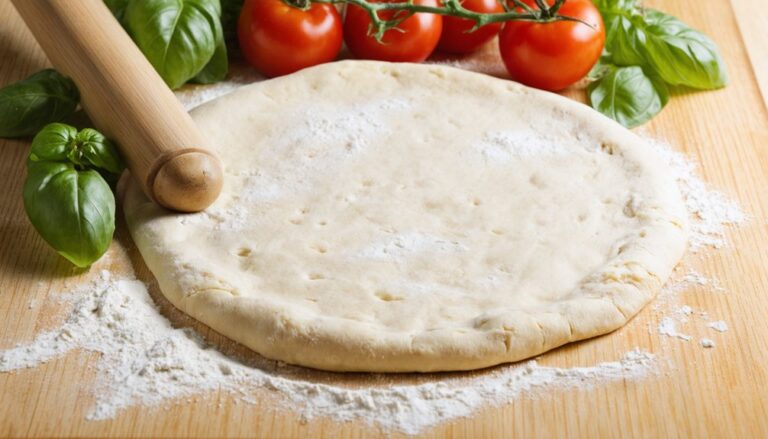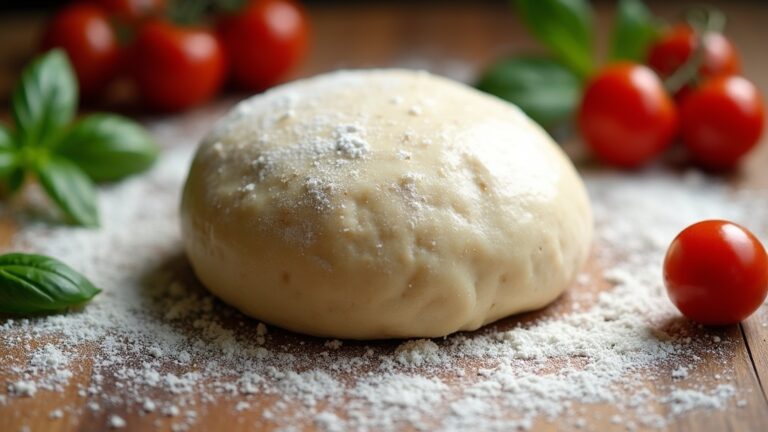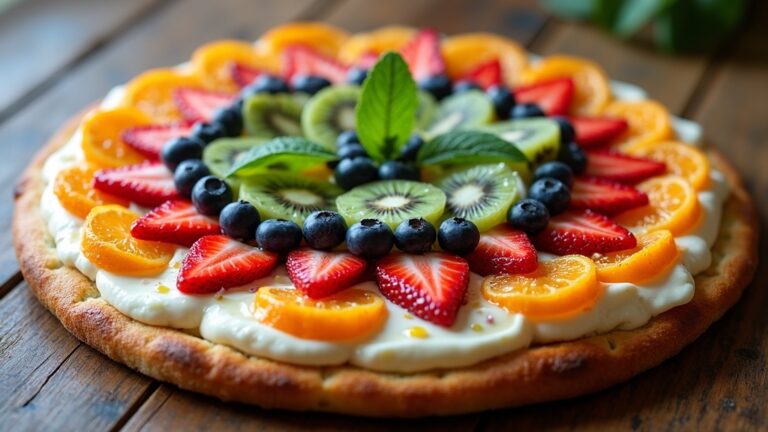Pizza Dough Recipe No Yeast
If you want a quick and easy pizza dough without yeast, I’ve got just the recipe for you! Start with 2 cups of all-purpose flour, 1 tablespoon of baking powder, a teaspoon of salt, and 1 tablespoon of olive oil. Slowly mix in 3/4 cup of water until the dough comes together, then knead until smooth. Roll it out, add your favorite toppings, and bake until golden. Stick around, and I’ll share some delightful variations and topping suggestions!
Contents
History
When I think about the history of pizza dough, I can’t help but feel a sense of wonder at how this simple staple has evolved over centuries. The pizza origins trace back to ancient civilizations, where flatbreads topped with various ingredients first appeared. As time progressed, regions infused their unique flavors and techniques, leading to countless dough variations. In Naples, the classic Neapolitan pizza emerged, showcasing a tender, chewy crust, while other cultures experimented with thicker bases or gluten-free alternatives. Each iteration reflects the local ingredients and culinary creativity, making pizza a global phenomenon. This fascinating journey from humble beginnings to innovative creations inspires me to explore the endless possibilities of pizza dough today.
Recipe
Making pizza dough without yeast is a convenient and quick alternative for those who want to enjoy homemade pizza without the long waiting times associated with traditional yeast-based doughs. This no-yeast pizza dough is easy to make and requires just a handful of ingredients that you likely already have in your kitchen. The result is a soft and pliable dough that is perfect for rolling out and topping with your favorite ingredients.
Enjoy homemade pizza in no time with this quick and easy no-yeast dough, perfect for any topping!
With this recipe, you can whip up a delicious pizza in no time. Whether you’re in the mood for a classic margherita or loaded with your favorite toppings, this dough will serve as a fantastic base. Plus, it’s a great option for those who may have dietary restrictions or simply want to avoid using yeast.
Ingredients:
- 2 cups all-purpose flour
- 1 tablespoon baking powder
- 1 teaspoon salt
- 1 tablespoon olive oil
- 3/4 cup water (add more if needed)
To make the dough, start by preheating your oven to 450°F (232°C). In a mixing bowl, combine the all-purpose flour, baking powder, and salt. Gradually add in the olive oil and water, mixing until the dough begins to come together. If the dough is too sticky, add a little more flour; if it’s too dry, add a bit more water. Once the dough forms a ball, knead it on a floured surface for a couple of minutes until smooth. Roll the dough out to your desired thickness, place it on a baking sheet or pizza stone, and add your favorite toppings before baking for about 12-15 minutes or until the crust is golden brown.
For the best results, make sure to roll out the dough evenly to guarantee it cooks uniformly. You can also experiment with different seasonings in the dough, like garlic powder or Italian herbs, to enhance the flavor. If you prefer a crispier crust, try pre-baking the crust for a few minutes before adding toppings. Finally, don’t hesitate to customize your pizza with fresh veggies, meats, or cheese to suit your taste. Enjoy your homemade pizza night!
Cooking Steps
Now that we’ve gathered our ingredients, let’s jump into the cooking steps that make this no-yeast pizza dough a breeze. I’ll guide you through mixing the dry ingredients, adding the wet ones, and kneading the dough until it’s perfectly smooth. Once that’s done, we’ll roll it out and get creative with our favorite toppings!
Step 1. Mix Dry Ingredients Together
To kick off our pizza dough recipe, I start by combining the dry ingredients in a large mixing bowl. This step is essential because the dry ingredient importance lays the foundation for our dough’s texture and flavor. Here’s what I include:
- All-purpose flour – it’s the backbone of our dough.
- Baking powder – for that light and airy crust.
- Salt – enhancing the overall taste.
- Olive oil – adding a touch of richness.
Using effective mixing techniques, I gently whisk these ingredients together to guarantee they’re well incorporated. This not only helps distribute the baking powder and salt evenly but also aerates the flour, giving our pizza a delightful texture. Trust me; this step sets the stage for a delicious pizza experience!
Step 2. Add Wet Ingredients Slowly
With the dry ingredients perfectly blended, it’s time to introduce the wet components to our pizza dough. I like to add the wet ingredients slowly, ensuring that I maintain the right wet ingredient ratios for a perfect texture. I pour in a small amount at a time, stirring gently as I go. This gradual mixing allows the flour to absorb the moisture without becoming clumpy. It’s fascinating to watch the dough start to come together, transforming from a dry mix into something cohesive. If it feels too sticky, I can always adjust by adding a touch more flour. This step is vital, so take your time and enjoy the process; you’re crafting something truly special!
Step 3. Knead Dough Until Smooth
Kneading the dough is where the magic truly happens. It transforms the ingredients into a cohesive masterpiece! To achieve the perfect dough consistency, I use a few essential kneading techniques:
- Push and Fold: Press the dough away with the heel of your hand, then fold it back over itself.
- Turn and Repeat: Rotate the dough a quarter turn after each push and fold, ensuring even texture.
- Use Light Pressure: Avoid overworking the dough; gentle yet firm is key.
- Check for Smoothness: The dough should be soft, elastic, and slightly tacky but not sticky.
As I knead, I can feel the dough coming together beautifully, ready for the next exciting step in our pizza-making journey!
Step 4. Roll Out the Dough
Once the dough is smooth and elastic, it’s time to roll it out into the perfect pizza base. I lightly dust my workspace with flour to prevent sticking and place the dough in the center. Using my rolling pin, I apply even pressure, employing various rolling techniques to achieve the ideal dough thickness. I prefer a thin crust, so I roll it out to about ¼ inch, but you can adjust according to your preference. As I rotate the dough, I make sure it maintains a circular shape, checking for any uneven spots. This process is all about patience and finesse. With the dough rolled out, I’m ready to move on to the exciting part—creating a delicious pizza masterpiece!
Step 5. Add Toppings of Choice
Now that the dough is perfectly rolled out, it’s time to release your creativity by adding toppings of choice. This is where the magic happens! I love to experiment with different topping combinations that tantalize the taste buds. Here are four of my favorite toppings to contemplate:
- Margherita: Fresh mozzarella, basil, and a drizzle of olive oil.
- BBQ Chicken: Shredded chicken, barbecue sauce, red onions, and cilantro.
- Mediterranean: Spinach, feta cheese, olives, and sun-dried tomatoes.
- Veggie Delight: Bell peppers, zucchini, mushrooms, and a sprinkle of Italian herbs.
Don’t hesitate to mix and match your favorite toppings to create a unique flavor profile. Enjoy the process, and let your pizza reflect your personality!
Nutritional Guide
While I love indulging in a delicious slice of pizza, I also want to be mindful of what I’m putting into my body. This no-yeast pizza dough offers a great balance between taste and nutrition. Here’s a quick nutritional guide to help you understand the caloric content and ingredient benefits:
| Ingredient | Caloric Content (per serving) | Benefits |
|---|---|---|
| Whole Wheat Flour | 100 | High in fiber |
| Olive Oil | 120 | Healthy fats, antioxidants |
| Water | 0 | Hydration, zero calories |
Using whole wheat flour boosts the fiber, while olive oil adds heart-healthy fats. With every bite, I feel good knowing I’m making a healthier choice without sacrificing flavor!
Final Thoughts
As I reflect on this no-yeast pizza dough recipe, I’m reminded of how easy it is to enjoy a homemade pizza without the wait for dough to rise. This recipe opens up a world of possibilities, allowing for delightful creativity with dough variations and topping suggestions. Here are a few ideas to inspire your next pizza night:
Reflect on the ease of no-yeast pizza dough, unlocking endless creativity for delicious toppings and unique variations.
- Cauliflower Dough – A healthier, gluten-free alternative.
- Herb-Infused Variants – Add fresh herbs for an aromatic twist.
- Whole Wheat Option – For a heartier, nutritious base.
- Cheesy Crusts – Incorporate cheese for added flavor and texture.
With these innovative approaches, you can craft a pizza that’s uniquely yours, ensuring every bite is deliciously satisfying. Enjoy experimenting!
Frequently Asked Questions
Can I Use Whole Wheat Flour Instead of All-Purpose Flour?
Absolutely, I’ve swapped all-purpose flour for whole wheat before. It adds a nutty flavor and more nutrients, though the dough texture might be denser. Embrace the benefits of whole wheat; it’s a delicious innovation!
How Long Can I Store Leftover Pizza Dough?
Ah, the great mystery of pizza dough storage! I’ve found it lasts about three days in the fridge. Just wrap it tightly to store, and watch it not become a doughy time capsule of despair!
Can I Freeze the Pizza Dough for Later Use?
Absolutely, I freeze my dough for later use! I wrap it tightly, ensuring no air can affect the dough texture. Using proper freezing methods keeps it fresh, allowing me to enjoy homemade pizza anytime!
What Toppings Pair Well With No Yeast Pizza?
Toppings are like a painter’s palette, creating a masterpiece on your dough. I love mixing gooey mozzarella with vibrant bell peppers and earthy mushrooms. Experimenting with unique cheese options and fresh vegetable toppings can elevate your pizza experience!
Is This Dough Suitable for Gluten-Free Diets?
I love experimenting with gluten-free alternatives! While this dough’s texture differs from traditional recipes, using ingredients like almond flour or chickpea flour can create a delightful base that’s perfect for your favorite toppings. Give it a try!
Conclusion
As I pull the golden-brown pizza from the oven, the aroma dances through the air like a warm embrace. This yeast-free dough may not rise like a traditional crust, but it holds its own, cradling toppings like a cherished secret. Each slice is a reminder that simplicity can lead to deliciousness. So, roll up your sleeves, and let this easy recipe be your canvas for culinary creativity. After all, a great pizza can transform any ordinary night into a celebration.


